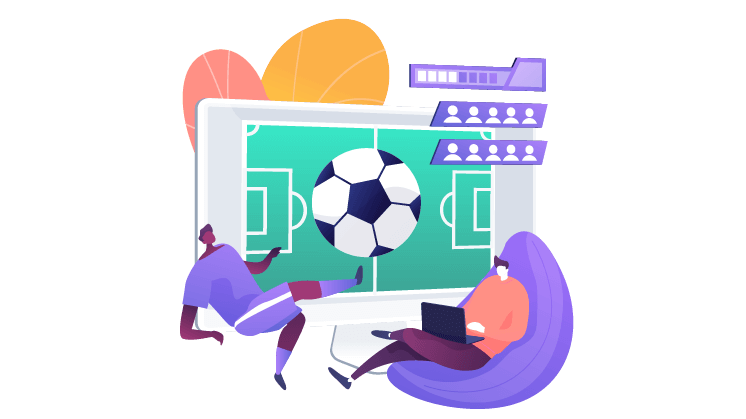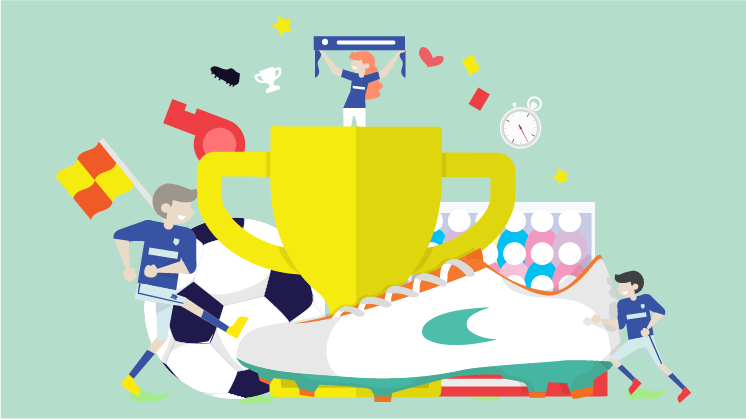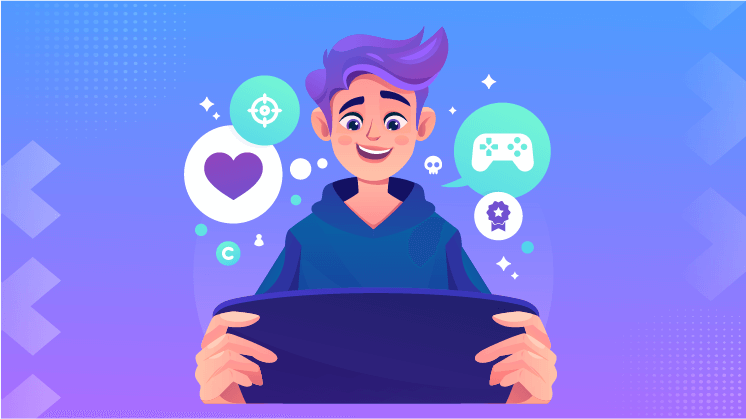Sports firms and clubs are tapping into the influence of gamification in sports to drive conversions and retention within their fan-engagement campaigns. Even though gamification can help brands keep their customers longer, industries with Direct-to-Consumer (D2C) business models have the most to gain.

Here’s why.
The sports industry can remarkably benefit from gamification experiences. They can drive revenue with merchandise sales, subscriptions, sign-ups, ticketing, and other conversions. Most of the time, the biggest value comes from direct marketing, data, personalization based on preferences and interests, and actionable insights.
Remember, gamification in sports doesn’t mean creating in-app games for users to play. When discussing “gamifying” an experience, we refer to using techniques that lead app users through standard experiences in ways that appear like games. “Gamify the experience” means making a task intuitive and fun, making it purposeful, and making the experience seamless—where every gamified element feels dynamic.
In this article, we have covered four ways where Wordpress Gamification in sports is proving to be a game-changer:
The Impact of Gamification in Sports
Gone are the days of passive spectatorship. Today, WordPress gamification plugins and custom solutions are turning fans into active participants. They create a thrilling, interactive arena extending far beyond the stadium walls. Let’s take a look at how gamification is impacting the sports industry:
How WordPress Gamification in Sports Boosts Fan Engagement:
- Stats that Speak for Themselves: 73% of sports fans actively engage with gamified experiences, compared to just 48% with traditional content. (Source: FanBytes)
- Beyond the Likes: A study by the University of Florida found that gamification apps increased user engagement by a staggering 83%. (Source: University of Florida)
How To Use WordPress to Power Gamification in Sports:
- Customization is King: WordPress offers a plethora of gamification plugins, from points and badges to leaderboard integrations and interactive challenges.
- Flexibility for Every Fan: Tailor the experience to your audience, whether virtual fantasy leagues, trivia contests for die-hard fans, or interactive prediction games for casual audiences.
How to Award Real-World Rewards & Virtual Victories:
- Incentivize the Crowd: Drive engagement with exclusive content, discounts on merchandise, or even tickets to premium events for top-performing fans.
- Beyond the Screen: Integrate gamification elements with physical experiences. Imagine fans earning points at the stadium they can redeem for concessions or merchandise!
How Gamification in Sports Builds Loyal Communities:
- Shared Passion, Shared Play: Gamification fosters a sense of community. It unites fans through shared goals and friendly competition.
- Amplify Advocacy: Empower fans to become brand ambassadors, share their achievements, and drive organic promotion through social media.
1. Official Sports Team Apps
When you download and open a sports team’s app, you are often encouraged to sign up or register to access exclusive games and content. This is an effective mechanism to capture first-party data regarding gamification in sports.
Sports organizations can capture data points that identify behavioral features by placing gamification elements across the app. For example, using exclusive video replay and matching image content with interactive layers—like a quiz or a poll—can help businesses gain behavioral insight from users, like their affinity for a specific player. Brands can use this to personalize the content the user observes. From then on, they can offer products they are likely to buy.
Using community involvement and moderated chat is another tried-and-tested method to increase user retention and gain voluntary 1st-party data from users. English football club Chelsea does this too. They had thousands of virtual attendees via the official ‘Chelsea 5th Stand’ app for a league match.
Another example is Goodwood with its SpeedWeek event. They applied gamification in sports mechanisms to reward users for proving their knowledge, making predictions, and offering opinions.
myCred has a WordPress gamification mechanism called Badges that it offers to its customers when it applies to reward points. Each badge represents a different level of achievement for any sports or other activity. Each player can get a badge when they reach a new level in any e-sport.
2. Fantasy Football Leagues
Sports fans come together to invest money, time, and passion in a competitive fan-to-fan tournament. They draw interest in the sport beyond their teams while attracting loyal usage, including continuous engagement and app downloads.
For example, the Fantasy Premier League, launched in 2002, connects over 7 million players globally every season.
By taking over the role of “manager,” fans can sell and buy players and collect reward points for goals, saves, assists, and other actions on the football pitch. This tactic can in gamification in sports garner
- sharable achievements
- highly-talkable topics, and
- “League Invite” that drives viral adoption.
Fantasy leagues have become a powerful tool for gamification in sports to drive insane engagement amongst current and new fans. Sports are vehicles for promotion in growth markets. Over two hundred thousand individuals play in India, which makes it a very competitive market for any sport.
Sometimes, the registration step often seems to be a barrier to entry. However, it is welcomed by fantasy players who respect the need to keep their scores updated. The game is also a funnel into merchandise, creating a dynamic, personalized click-through to online individual club shops.
3. eSports
One of the major impacts of gamification in sports is eSports. It is a competitive experience concerning gamification in sports where fans compete against each other in front of a spectating audience, similar to traditional sports. Competitors from different eSports teams or leagues face off in the same games popular with in-house gamers: League of Legends, Fortnite, Call of Duty, Counter-Strike, Overwatch, and Madden NFL, to name a few.
eSports offer a competition with prizes and points to be won, reward cycles, and leaderboards, keeping users hungry and engaged for more. This form of gamified experience is a powerful experience for attracting a global fan base. Many sports teams have well-funded and branded esports teams; some leagues have their own official eSports leagues. During the coronavirus restrictions, eSports was a good way to keep fans interested in an event before, during, and after it.
The French LFP was the first major football league organizer to make and run an in-house virtual league when, in 2016, it collaborated with its FIFA title and EA to launch e-Ligue 1. They have had over 100,000 players virtually represent their teams, including real-life professional footballers, 32,000+ engaged social media followers, and over 129,000 games played. This activity led to media coverage and regular news, furthering their relationship with sponsors.
As per LFP Media Director the whole project has been a real success in extending knowledge and reaching out to their fan base.
4. Sports Betting
Different sporting firms harness the betting industry to drive sponsorship and increase brand awareness. Betting businesses use betting tactics through gamification in sports to increase interest and attract new users. Through prediction bets, or “what will happen at ‘x’ time” forms of bets, sports fans feel they have the skill to engage with their betting product. In turn, they spend more time following the teams in question to learn more about their corporate brand.
Participation & Enthusiasm
Gamification can also be used to increase participation in sports, especially among young people. For example, gamified fitness apps can make physical activity fun and engaging for kids and teenagers. This can help to encourage them to be more active and to develop a lifelong love of sports and physical fitness.
Gamification in sports can also be used to promote participation in recreational sports leagues and tournaments. For example, some leagues use gamified systems to reward players for their participation and for their contributions to their teams. This can help to create a more competitive and engaging environment for players and to encourage them to keep coming back.
Athlete Performance
Gamification can be used to help athletes improve their performance in a number of ways. For example, wearable devices can be used to track athletes’ progress and provide them with real-time feedback on their performance. This feedback can help athletes identify areas where they need to improve and make adjustments to their training accordingly.
Gamification in sports can also be used to create more engaging and challenging training experiences for athletes. For example, virtual reality (VR) can be used to create simulations of real-world competition scenarios. This allows athletes to practice under realistic conditions and to develop their skills and strategies in a safe and controlled environment.
The Future of Gamification in Sports
Gamification in sports is still a relatively new concept. However, it is already creating a significant impact. As technology continues to develop, we can expect to see even more innovative and engaging gamification experiences emerge in the future.
For example, we may see the use of blockchain technology to create more secure and transparent gamified systems. We may also see the use of artificial intelligence (AI) to create personalized, gamified experiences tailored to each user’s individual needs and interests.
Strengthened Loyalty
Loyalty programs integrate gaming elements like collecting digital badges and winning unique experiences through points earned from purchases and engagement. Gamified loyalty programs create deeper connections between fans and teams.
Isn’t it interesting?
Final Words
The four methods concerning gamification in sports can spike fan engagement. Moreover, it will depend on the particular business outcome and audience you need to drive. Still, gamification is a mechanism to garner engagement with a larger audience during, before, and after match day.



